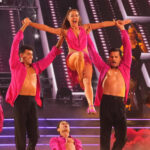For those unfamiliar with the world of ballet, the terminology can sometimes be confusing. If female ballet dancers are gracefully called ballerinas, what is the appropriate term for their male counterparts? The answer is quite straightforward, though there are nuances depending on their role and status within a ballet company.
Generally, a male ballet dancer is called a danseur. This is the most widely accepted and encompassing term. However, much like in any profession, there are distinctions in rank and title that further define a male dancer’s position.
Danseur: The Core Term for Male Ballet Dancers
The term “danseur” is French in origin, reflecting ballet’s historical roots in France. It simply translates to “dancer” in French, but in the context of ballet, it specifically refers to a male dancer. You can think of “danseur” as the general term, much like “actor” for a male performer in acting.
Alt text: A danseur executes a dynamic pose mid-performance, showcasing strength and artistry.
Principal Dancer: Reaching the Pinnacle
Within a professional ballet company, dancers are ranked to denote their experience, skill, and the roles they perform. The highest rank a male dancer can achieve is principal dancer. Just as a prima ballerina is the leading female dancer, a principal dancer is a leading male dancer.
A principal dancer is not just any male dancer; it signifies a dancer at the top of their profession. They are the stars of the company, performing leading roles in ballets like Swan Lake, The Nutcracker, and Romeo and Juliet. These roles demand exceptional technical skill, artistry, and stage presence. Therefore, while all principal dancers are danseurs, not all danseurs are principal dancers. It’s a title earned through years of dedication and exceptional performance.
Beyond the Stage: The Life of a Danseur
The life of a danseur extends far beyond the captivating moments on stage. When they are not performing, male ballet dancers are deeply engaged in rigorous training and preparation. Their daily routine is demanding, typically starting with a ballet technique class to refine their skills and warm up their bodies. This is followed by extensive rehearsals, sometimes lasting for six hours or more, as they prepare for upcoming performances.
Alt text: Male and female dancers participate in a ballet class, practicing at the barre to hone their technique.
Just like any athlete, a danseur must maintain peak physical condition. This includes a balanced diet to fuel their demanding physical activity. Contrary to some misconceptions, dancers eat a variety of foods to sustain their energy levels. They require ample energy to endure the physical exertion of rehearsals and performances.
Pointe Shoes and Male Dancers: Debunking Myths
Pointe shoes are iconic in ballet, but they are typically worn by female dancers. Pointe shoes are meticulously crafted from layers of fabric and glue, covered in satin, and provide the support needed for ballerinas to dance on the tips of their toes. They are not made of metal, wood, or cement, but rather a combination of materials that offer both structure and flexibility. While male dancers do not wear pointe shoes, they have their own specialized ballet shoes designed for their movements and roles.
Alt text: A detailed view of pointe shoes, showcasing the satin exterior and ribbons used to secure them.
The Journey to Professionalism
Becoming a danseur, especially a principal dancer, is a journey that requires immense dedication and years of training. Aspiring dancers typically begin their training around the age of seven, starting with foundational ballet technique classes. As they progress, the intensity of training increases, often involving 10-15 classes per week, encompassing various disciplines such as ballet technique, jazz, modern, and partnering. This rigorous training, spanning 8-10 years, is essential to develop the strength, technique, and artistry needed for a professional career.
A Career Beyond the Stage
While a dancer’s performing career might have a similar length to that of other professional athletes, their involvement in the world of ballet often continues. After retiring from the stage, danseurs can transition into roles such as ballet masters, choreographers, instructors, or pursue entirely different paths, often enriched by the discipline and skills honed through their dance careers.
In conclusion, while there isn’t a direct male equivalent to “ballerina,” the term danseur is the correct and widely used term for a male ballet dancer. And for those who reach the highest echelons of their profession, they are celebrated as principal dancers, the leading men who grace the stage with their talent and artistry.


